Key takeaways
Another article about customer journeys? You betcha! Aren’t there enough already? No. Why? Too many people make mistakes while mapping out their customer journey. We want to help you avoid the common pitfalls and discover the advantages getting your customer journey right.
What is a Customer Journey?
Most of our innovation tracks start with one of the following statements:
“We heard at an innovation conference that we need a frictionless experience for our customer.”
“In San Francisco, you can get everything with the click of a button.”
“Alibaba and China are coming for us!”
“We need to increase the convenience for our customers.”
“We need to build an app that solves everything.”
*Disclaimer: I might have added some drama
I can truly understand why leaders inside companies struggle with those statements. They have a business to run, and at the same time, they’re being bombarded with the constant feed of disruptive news.
As an external consultant, I have a unique view on your business. I facilitate, inspire, and help teams reach useful insights and actionable to do’s. One of the main instruments I use is the customer journey. It bundles a lot of critical information about your company, teams & customers.
How Do You Create a Customer Journey?
Over the years I’ve helped create and analyze customer journeys with both startups and big companies. I gathered most of my learnings and best practices in a handy step-by-step process that I’m about to share with you.
Step #1: Identify the Start and End Point
Take a blank sheet of paper, and let’s get to work. You’ll probably need a big one.
Think about your business and the products you’re selling. Customer journeys always have a start and an end:
The start is where your customer places an order, buys your product or requires your services.
The end is where you deliver the product to your customer (being it online or offline)
(I know that there are steps before the start and after the end, but bear with me, we’ll get there)
On the left side of your paper write down your start point, and on the right put the endpoint.
Something like this:

Some examples, if you’re having a hard time:
You produce T-shirts, and you distribute them through clothing shops. The shop ordering a box of T-shirts is your start. You delivering it to the shop is the end.
You created an online HR software and sell it online to HR managers from big companies. The HR manager filling in their credit card details is your start. You giving access to the product is the end.
Surprise!
Today I’d like to focus on “traditional” businesses, that don’t sell online software.
There’s already a truckload of articles about customer journeys and customer onboarding for Software as a Service companies. I do think they are relevant for more traditional businesses, but take a look at them during another time. You’re now reading mine!
If you really can’t wait, here are my two favorites:
Step #2: Map the Steps in Between
We have lift-off!
Now, we need to map all the steps between the start and the end. Let’s walk you through an example.

If we look at the customer journey of company X, these are all the steps:
- Cedric sends an email to Thomas with an order
- Thomas processes the order
- Thomas sends the order to production
- Production makes the T-shirts
- Production delivers the T-shirts to transport
- Transport delivers the T-shirts to Joe
- Cedric receives the package
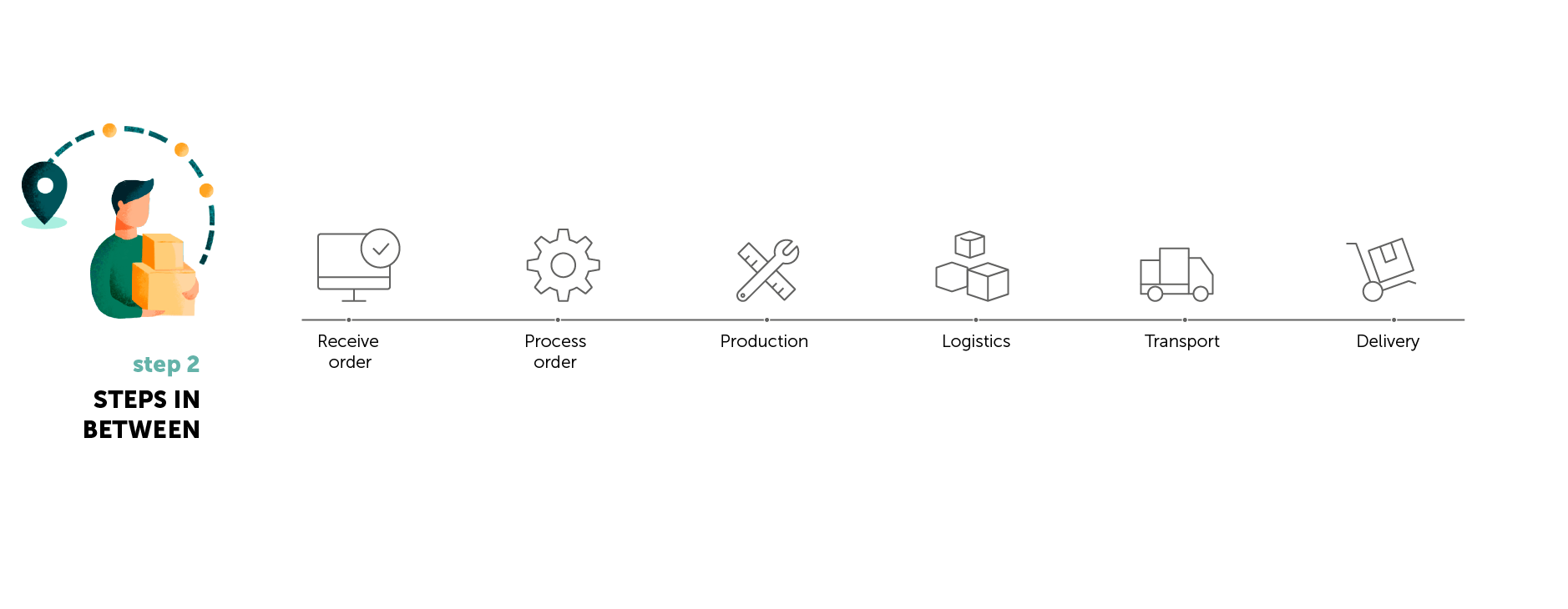
Step 3: Get to work with your team
Time to involve your team. They’re the experts in each step in your customer journey. If we take a closer look at each of the steps above, we could categorize them for each department of your company. You could say that every department is responsible for a part of the customer journey.
Sales & Marketing
- Cedric sends an email to Thomas with an order
- Thomas processes the order
- Thomas sends the order to production
Production
- Production produces the T-shirts
- Production delivers the T-shirts to transport
Logistics
- Transport delivers the T-shirts to Cedric
Customer Support
- Cedric receives the package
I’m fully aware that each company is different, and has more or less departments, but it’s up to you to define what matters most in your customer journey. I deliberately added the marketing department to the first 3 steps. They work closely together with sales to generate customers and revenue.
Now, other departments you might consider inviting to the party:
- HR
- Operations
- Finance
Once you have defined all of the relevant departments in your company, you need to identify the people you want to assign some homework to.
Homework? We’re in the customer journey school, so you better do it!
The goal is to expand our very simple customer journey into a more detailed one. Therefore, we need to ask for some help from the experts inside your company. The ones that are in charge of each task and have mastered every step of the way. In our innovation tracks, we use the following framework:
- Identify every head of the department: VP Sales, Production Manager, HR Director
- Plan a one-hour meeting with each of them separately
- Ask them to invite 1 team member that is in charge of performing the tasks (sales rep, production worker, marketeer)
- Send them the first version of your customer journey
- Ask them to detail every step in their respective field (HOMEWORK)
- Have a meeting to discuss their homework and detail every step
Let’s get back to our example.
Alex, the production manager of T-shirt company X, is in charge of the production facility of the T-shirt company. He detailed the production process into the following steps:
- Production manager receivers the order
- Production manager analyzes the production capacity
- Production worker receives the order
- Production worker sews the T-shirt
- Production worker packs the T-shirt
See what Alex did? He detailed the entire production process into 5 steps. Nice work, Alex. A Plus!
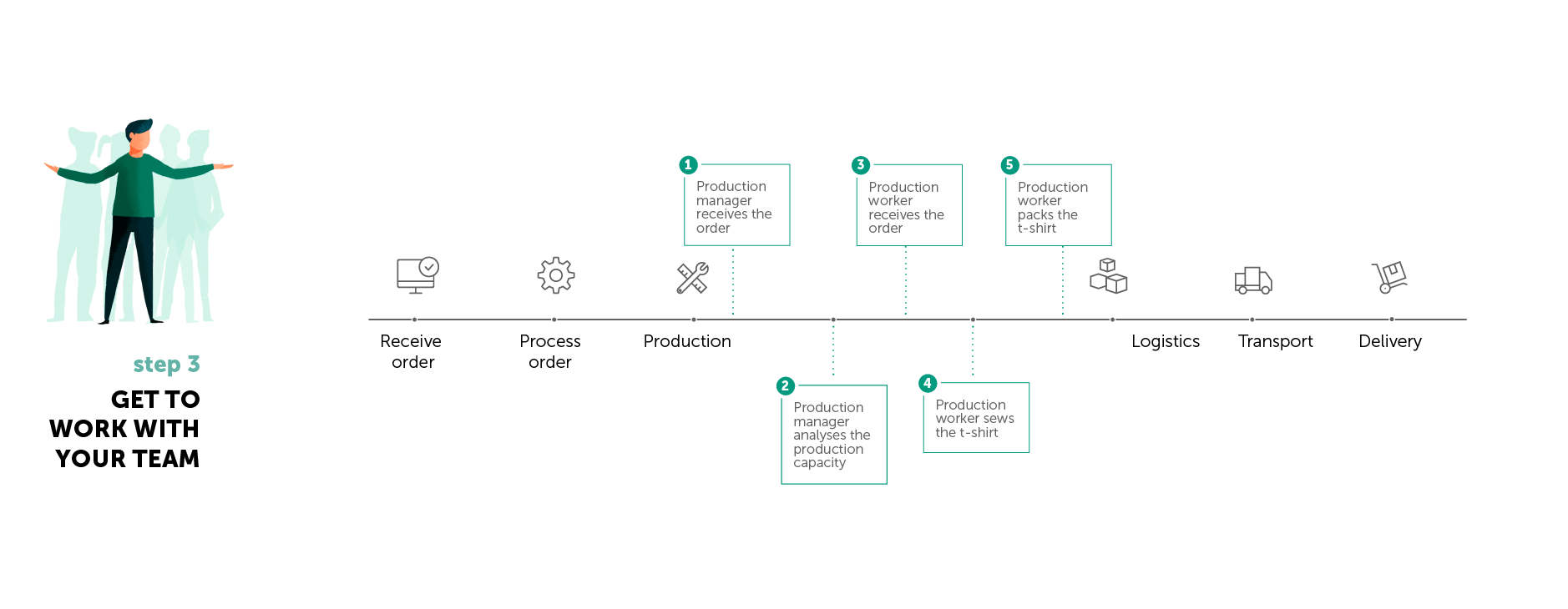
Step #4: Identify Internal Trends
I just love innovation conference quotes! Here’s another one that applies to customer journeys:
“Every company is a data & technology company”
In this case, the innovation gurus are right.
Data collection should be the number one priority for every company. It helps you analyze and identify friction in everything you do. It definitely applies to improving your customer journey.
So if you collect data, now is the time to process it, using your customer journey as a guideline.
Some questions that data could answer:
- How much do our customers spend on average?
- How long does it take to process an order?
- What’s the average production time of our products?
- What’s our average delivery time?
- How many customer complaints do we get?
Once you gathered the data, you need to analyze it using your customer journey as a guideline. Derive insights and friction points.
We can now answer 2 questions and derive an insight that might be useful:
- What’s the average production time of our products?
3 days
- What’s our average delivery time?
1 day
Hmm that’s weird. Our website states that our products are delivered within 3 days. However, our data shows that we’re not able to keep that promise because our production process takes too long.
You need to capture that insight on your customer journey.
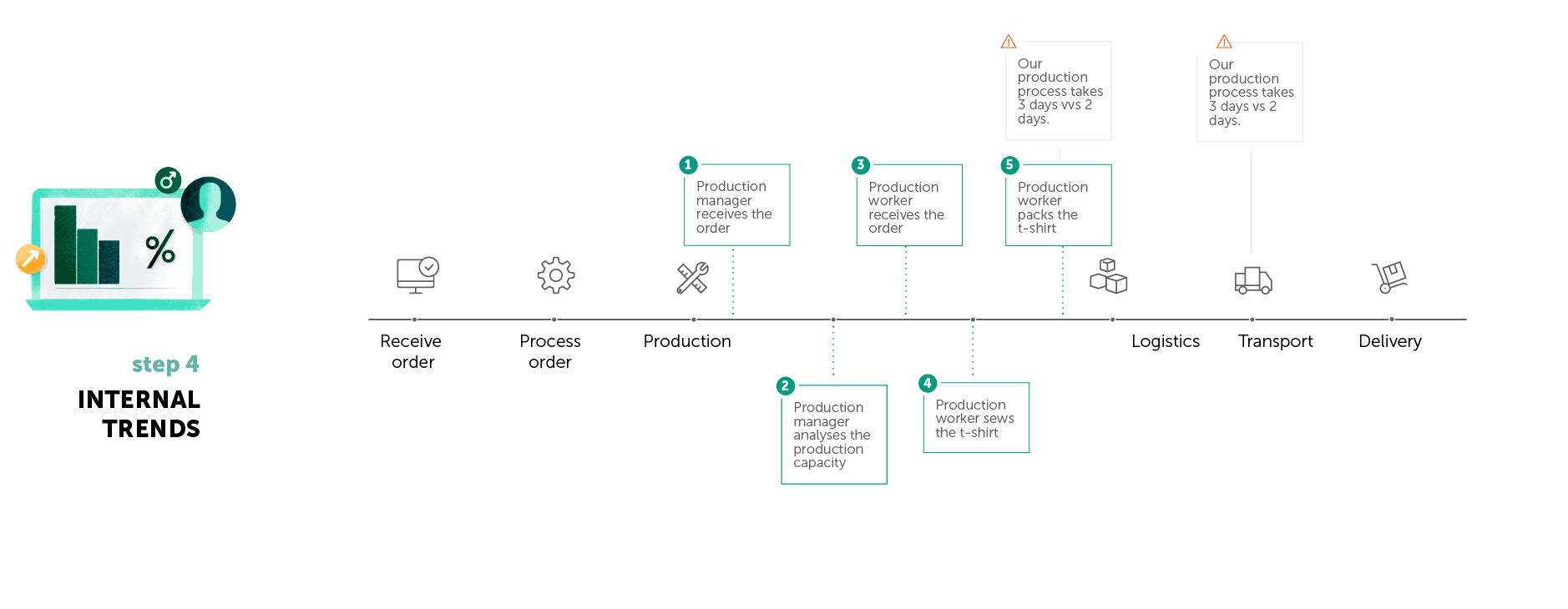
Step #5: Identify External Trends
It’s time for a field trip.
You’re probably aware of your competition, and what they’re doing. I want you to look at other companies to see how you can take inspiration and learnings from them.
How can you approach this?
- Hero Brands: create a list of the brands that you love as a B2C customer. Analyze what they are great at, and why you really love them.
- Competitors: create a list of your direct and indirect competitors (see image below for a framework). Map out their customer journey, highlighting the main differences and similarities.
- Disruptions: visit websites like Product Hunt, TechCrunch, Recode,… and search for specific terms of your customer journey. You’ll probably end up with small companies trying to solve a part of your customer journey. You could either partner up with them, use their software or decide to acquire them. It’s up to you.
If you found inspiration, add it to your journey. Make sure to highlight why you put it there: partnership, threat, inspiration…

Step #6: Involve Your Customers
It wouldn’t be called a customer journey if your customers weren’t involved. It seems so obvious, but it isn’t. A lot of companies fail in proactively talking to their customers and identifying friction or growth opportunities.
It’s time to have a sit down with your clients to talk about the future of your business. This is frightening for a lot of companies. They’re convinced that the sales and customer support teams already have the key to unlocking customer feedback, but that feedback often lacks context and is scattered all over the company.
Why should you sit down with your customers?
If you use your customer journey as a guideline, you’ll unlock actionable feedback. It will help you shape your future frictionless customer journey.
How do I sit down with my customers?
First of all, you need to create a list of customers you’d like to invite. It’s important to have some variety. We prefer having face to face conversations and discussions, instead of online surveys. The latter can be used to validate what your small group of customers proposes as improvements.
In previous innovation tracks, we tried to include the following set of customers:
- Existing BIG customers: who are your top performing customers?
- Existing SMALL customers: who are your small volume customers?
- Recently left customers: who are the customers that recently left your organization?
- Recently joined customers: who are the customers that just joined your organization?
- Nonexistent customers: who are the customers you would love to have on board?
We often aim to have 15 people in the room to do this exercise.
What’s the purpose of this exercise?
Once you have managed to invite 15 people to your office for a workshop, it’s time to prepare. You don’t want to waste anyone’s time. They’re doing you a huge favor coming to your office and helping you get better at what you do.
Preparing your customer workshop:
- Print one poster for each step of your customer journey—if you have 5 steps, you should have 5 template posters
- Write down each step of your customer journey on a separate poster
During the workshop:
- Get everyone in one room
- Divide the larger group into smaller groups of 5 people
- Each member of the group gets assigned a poster
They each get 5 minutes to answer the following questions:
- Why does your company excel at this step?
- What could be improved?
- How would you improve it?
- Switch posters every 5 minutes
- When all the posters have been processed, every member of the group needs to present what’s on their poster
- Discuss the main findings with the group
- Capture the main takeaways
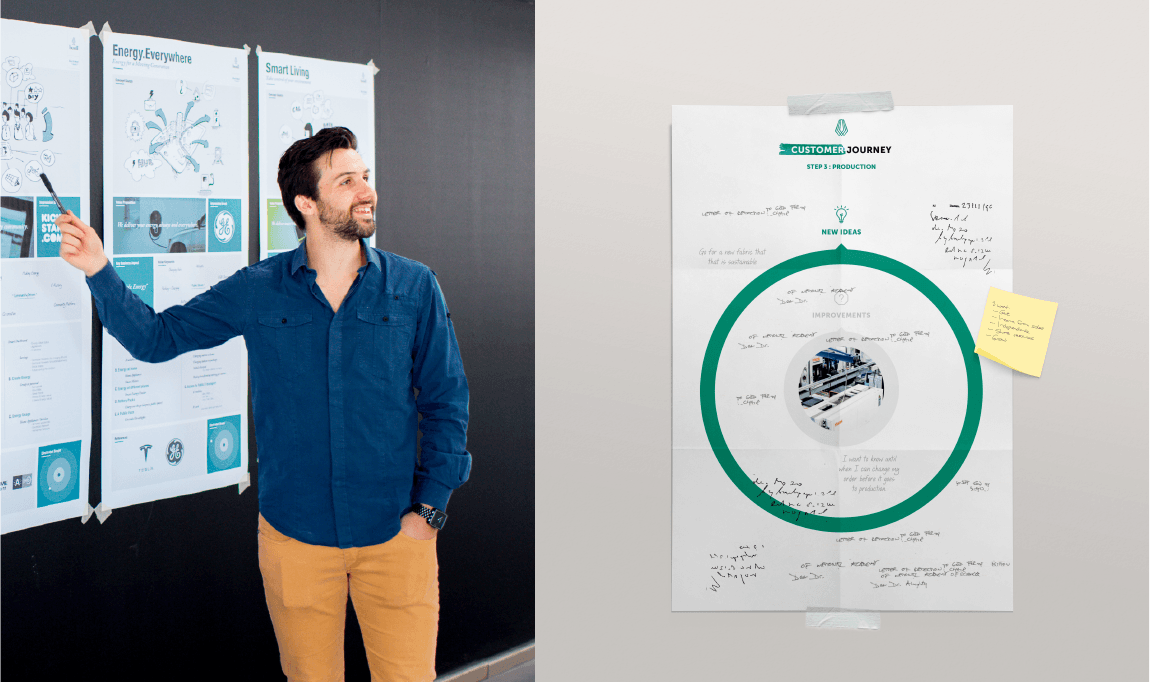
Unlocking a group discussion is key at this stage. Your customers will talk about how they experience the interactions with your company every step of the way.
Final question to your customers:
- List the 3 most important things you would want to be improved in the customer journey
After the workshop:
Normally, you should have captured loads of feedback from your customers. You should be able to rank all feedback in the following buckets:
- Major pain points
- Improvements
- Nice to have
Make sure to filter out the least important things. Never ever throw away any form of feedback, but create a “backlog” of ideas for future improvements. Focus on the most important pain points and frictions to start off with.
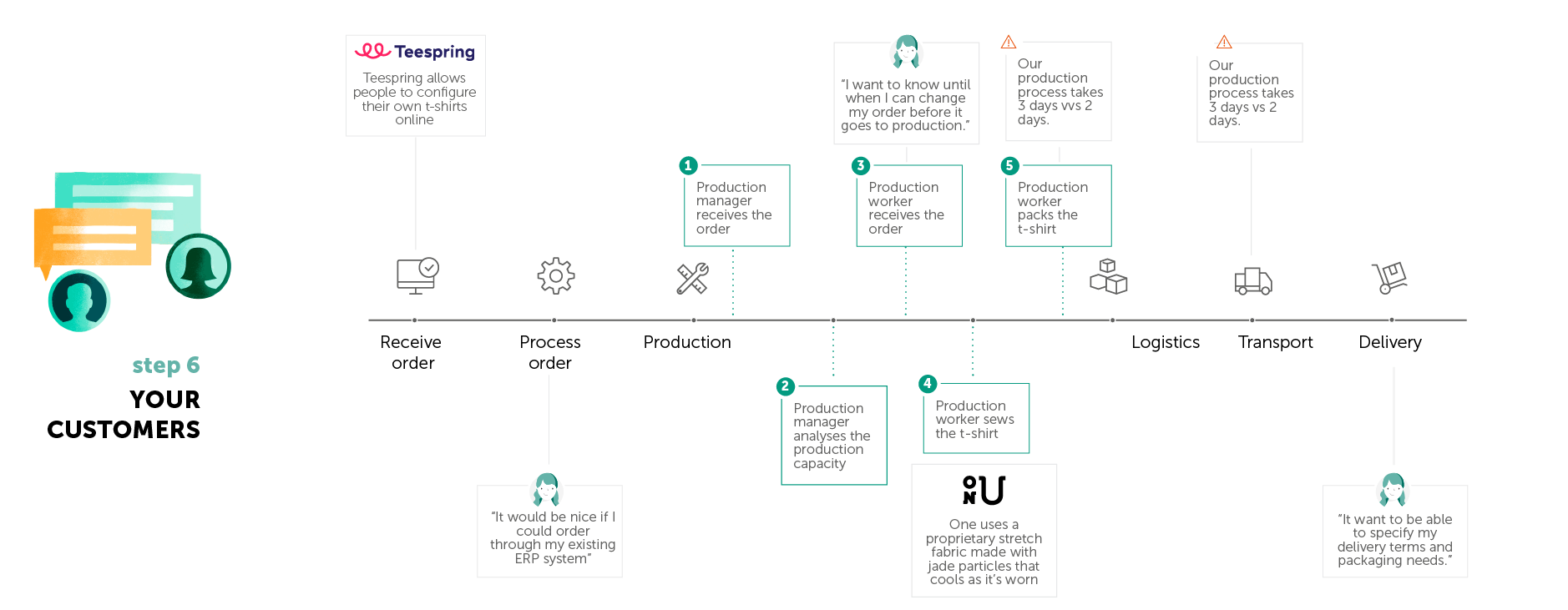
Step #7: Don’t forget the steps before and after the customer journey
A lot of companies tend to forget the journey before a customer orders a product and after they receive it. During your customer workshop you should have uncovered their main buying intentions and how they decide to order your product.
In recent workshops, we uncovered some interesting insights that might be a crucial part of your customer journey:
- Customers hate ordering through email and want an online order platform
- Customers want integrations with their current online systems (CRM, ERP)
- Customers want an inventory management system
The same applies for the journey after you’ve delivered your product:
- Customers want to have easy access to technical documents about your product
- Customers want an easy way to re-order products
Bringing it home:

Normally your customer journey should look like this. Ladies and gentlemen, this is a powerful document. Creating this document made you:
- Think about your internal processes
- Collaborate and discuss certain processes with your team
- Realize you should capture data every step of the way
- Draw inspiration from what’s happening outside of your company walls
- Talk to your customer and experience their customer journey
What can you do with this document?
Hang it on your wall. In a place where a lot of people pass by. Make it a collaborative document. One that is open for discussion.
Apart from that, you could do the following:
- Create a roadmap using the following structure:
- Immediate to do’s
- To explore
- The future
- Assign the immediate to do’s to the right people and guard their progress
- Set up teams/squads and free up the budget to explore ideas that have been identified as opportunities.
It’s important to realise that this is a living document. You’re never done optimising, innovating, or even radically changing your business.
If you’re piloting your MVP with real customers, make sure your customer journey is carefully crafted.








